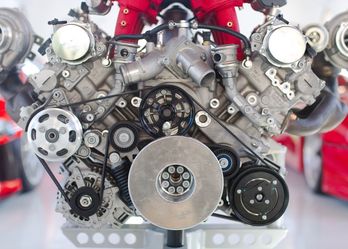INDEPENDENT DEALER
Frederick, MD & Hagerstown | (301) 416-0575
OUR BLOG
Each part of the engine plays a vital role in the overall performance and efficiency of the vehicle. Read this post by Alf Marketing in Frederick, MD to learn more about car engine parts.

Car engines are complex machines made up of many interconnected parts, and they're all crucial in ensuring the vehicle operates smoothly and efficiently. Understanding the basic car engine parts can help drivers better appreciate the importance of regular maintenance and recognize potential issues before they become significant problems.
Are you ready to keep your engine working perfectly? Call Alf Marketing in Frederick, MD at (301) 416-0575 or visit AMSOIL's online store to find the highest quality maintenance products for it.
Learning About Car Engine Parts
1. Cylinder Block
The cylinder block is the foundation of the engine and houses the cylinders, where the engine's combustion process takes place. It's typically made from cast iron or aluminum alloy, providing the necessary strength and durability to withstand the high pressures and temperatures generated during combustion. The block also includes various passages for coolant, oil, and sometimes the crankshaft.
2. Cylinders and Pistons
Cylinders are hollow spaces in the engine block where pistons move up and down. Pistons are cylindrical components that move within the cylinders, driven by the combustion of the air-fuel mixture. An engine typically has four to eight cylinders, although some engines may have more or fewer. The movement of the pistons turns the crankshaft, converting the linear motion of the pistons into rotational motion, which powers the vehicle.
3. Crankshaft
The crankshaft is a long, rotating shaft located within the cylinder block. It's connected to the pistons via connecting rods and is responsible for converting the up-and-down motion of the pistons into rotational motion. This rotational motion is then transferred to the wheels, allowing the car to move. The crankshaft also drives other engine components, such as the camshaft and timing belt.
4. Camshaft
The camshaft controls the opening and closing of the engineâs intake and exhaust valves. It's driven by the crankshaft and rotates at half the speed of the crankshaft in a four-stroke engine. The camshaft has lobes, or cams, that push on the valves, causing them to open at precise times during the engine's cycle. This timing is crucial for the efficient operation of the engine, ensuring that the air-fuel mixture enters the cylinders and exhaust gases are expelled at the right moments.
5. Valves
There are two types of valves in an engine: intake and exhaust. Intake valves allow the air-fuel mixture to enter the cylinders, while exhaust valves allow the combustion gases to exit. Each cylinder typically has at least one of each, but modern engines often have more to improve airflow and efficiency. The camshaft controls the opening and closing of these valves, which enables the engine's breathing and performance.
Use AMSOIL Signature Series 5W-30 Synthetic Motor Oil, the best synthetic oil in Frederick, MD to protect your engine fully.
6. Fuel Injectors
Fuel injectors are responsible for delivering fuel into the engine's cylinders. They spray a fine mist of fuel directly into the combustion chamber, where it mixes with air before being ignited by the spark plug. In modern engines, fuel injection systems are electronically controlled, allowing precision over the amount and timing of fuel delivery. This improves fuel efficiency, reduces emissions, and enhances overall engine performance.
7. Spark Plugs
Spark plugs are small devices that create a spark to ignite the air-fuel mixture in the engine's cylinders. They're located at the top of each cylinder and receive a high-voltage charge from the ignition coil. The spark causes the fuel mixture to combust, generating the energy needed to move the pistons. Check and replace the spark plugs regularly.
8. Timing Belt/Chain
The timing belt or chain synchronizes the rotation of the crankshaft and camshaft, so the engine's valves open and close at the correct times during the combustion process. If these fail, it can cause severe engine damage, as the pistons may collide with the valves. Therefore, you must replace them according to the manufacturer's recommended intervals.
9. Oil Pump
The oil pump is responsible for circulating engine oil throughout the engine to lubricate moving parts, reduce friction, and help cool the engine. Without proper lubrication, the engine's components would wear out quickly, leading to overheating and potential failure. The oil pump ensures that oil reaches all necessary parts of the engine, making it a vital component for engine longevity.
10. Exhaust System
The exhaust system removes the combustion gases from the engine and directs them out of the vehicle through the exhaust pipe. This system includes components like the exhaust manifold, catalytic converter, and muffler. The exhaust manifold collects gases from the engine's cylinders, the catalytic converter reduces harmful emissions, and the muffler dampens the noise produced by the engine.